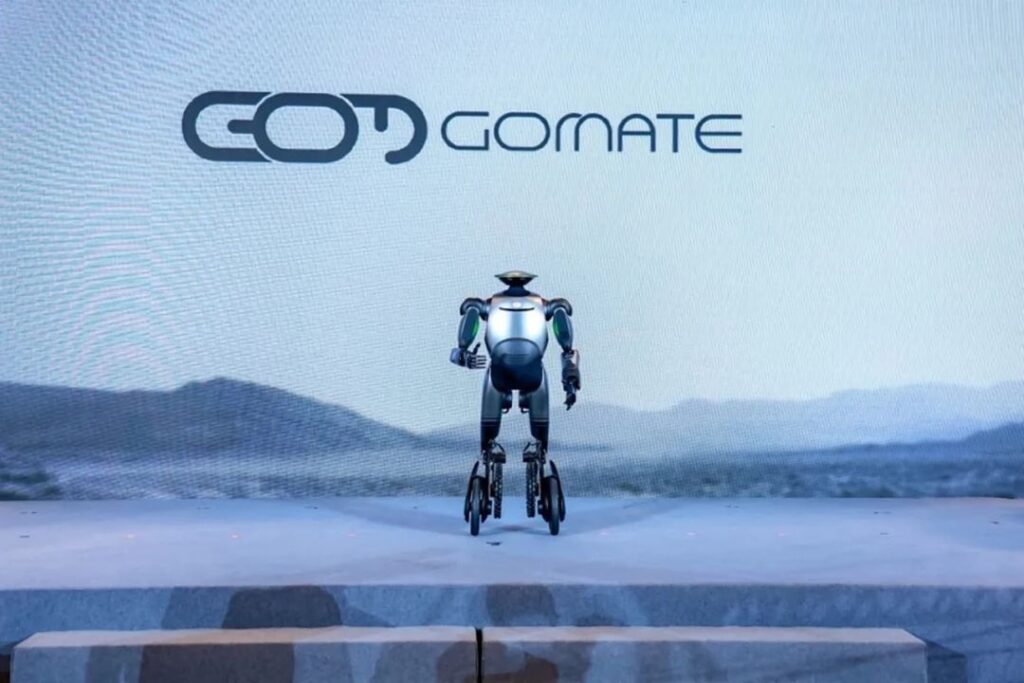For robotics companies, the ability to deploy machines in real-world scenarios has always been a make-or-break factor. Among various application areas, industrial manufacturing—particularly in automotive factories—remains a dominant use case.
Compared to complex environments like outdoor spaces, households, or retail settings, factories provide relatively stable and predictable conditions, alongside abundant real-world data that is ideal for training robots. Additionally, the technological overlap and supply chain synergies have drawn automakers’ attention to robotics, leveraging their strengths in data and production to seize emerging opportunities.
Recently, GAC Group entered the competitive robotics landscape by unveiling the third generation of its humanoid robot, GoMate. This innovation features a variable wheel-leg mobility structure, seamlessly integrating the key design paradigms of wheeled and legged robots. GoMate can switch between two-wheel and four-wheel modes, enabling it to navigate diverse terrains, such as flat surfaces and slopes.
Unlike some companies that target automotive manufacturing as a primary use case, GAC has chosen to focus GoMate’s initial commercialization efforts on security, elderly care, and after-sales automotive services. Currently undergoing field tests, GoMate represents GAC’s strategic shift toward addressing more immediate needs.

Zhang Aimin, head of humanoid robot R&D at GAC, explained the rationale to 36Kr:
“Automotive manufacturing is not GAC’s priority at this stage. We aim to focus our early efforts on more pressing and immediate needs. Take security, for example. It’s evident that passive security systems are gradually being replaced by active security systems. Robots that can proactively detect dangers and initiate responses represent a huge market potential.”
According to information obtained by 36Kr, GAC plans to launch its security humanoid robots in the first half of 2025. The company intends to begin mass production of self-developed components for global distribution by midyear, with small-batch robot production in 2026, followed by scaled manufacturing.
GAC’s entry into the humanoid robotics space comes relatively late. Since 2023, interest in embodied intelligence has surged, with automakers such as Tesla, BYD, Xpeng Motors, Nio, and Chery actively announcing developments in the field. These companies have ramped up efforts by recruiting engineers, forming dedicated R&D teams, and initiating product rollouts.
Unlike startups, automakers tend to possess abundant funding, extensive resources, and access to real-world application scenarios—advantages that enable them to take more direct paths into the embodied intelligence field.
On the software and algorithm side, automakers can utilize end-to-end (E2E) large models originally developed for autonomous driving. For instance, GoMate builds upon GAC’s autonomous driving technology. Zhang’s team combined the traditional perception-decision-control framework with E2E models during training, integrating them into a unified world model. This cohesive approach enables raw data to be processed into actionable trajectories or control commands, improving the robot’s generalizability, decision-making reliability, and movement flexibility.
Yet, there are significant differences between applying these technologies to autonomous vehicles and humanoid robots. Zhang said:
“The control dimensions in autonomous vehicles are relatively simple, and data collection is easier, but the safety requirements are extremely high. In contrast, humanoid robots face greater technical challenges, particularly in data collection and skill generalization. However, their safety advantages make them more effective in specific application scenarios and tasks.”
On the hardware side, automakers like GAC benefit from established, mature supply chains, providing a significant cost advantage.
For example, humanoid robot components developed by GAC fall into two categories: basic parts and critical components. Basic parts are sourced through GAC’s robust supply network, keeping procurement costs low. Meanwhile, critical components—such as actuators, motors, and dexterous hands—are independently designed and manufactured by GAC. By repurposing automated production lines and controlling raw material costs, the company managed to lower production expenses for its humanoid robots.

Other automakers are also rapidly advancing their robotics initiatives. Companies such as Dongfeng Liuzhou Motor, BYD, and Nio have partnered with UBTech Robotics, whose Walker S humanoid robots have already been deployed for training in multiple factories. BYD has even posted recruitment notices for building an embodied intelligence research team, while BAIC Group has entered the market through its subsidiary, BAIC Capital, which has invested in robotics companies like Galbot and PaXini Technology.
Zhang told 36Kr that the security industry has experienced significant shifts in recent years, with growing demand for next-generation systems. Unlike passive security measures, which rely on reactive responses and are prone to blind spots, active security systems are emerging as the new standard.
By integrating sensors, large models, and multi-layered defense systems, GoMate security robots can autonomously patrol managed areas, analyze real-time environmental data using algorithms, identify abnormal behaviors or potential threats proactively, and implement appropriate safety measures.

For instance, in areas with multiple stores that stock flammable or explosive materials, GoMate can intensify patrols of fire hydrants and other fire prevention equipment during dry weather. By incorporating data such as temperature, humidity, and other environmental factors, the robot can predict fire risks and help prevent potential incidents.
In addition, GoMate supports intelligent, multi-tiered defense capabilities. These include rapid authorization for smart wearable devices and seamless compatibility with artificial intelligence-integrated surveillance systems, smart gates, drones, and other technologies. For example, the robot’s dexterous hand can be replaced with tools like a shield or baton, enhancing the safety and effectiveness of security personnel.
Energy efficiency is another crucial feature. With the ability to operate for over six continuous hours, GoMate can switch to a four-wheel mode on flat terrain, allowing some motors to shut down autonomously. This reduces energy consumption by up to 80%, lowering operating costs and improving sustainability.
China’s smart security industry achieved an annual output value of approximately RMB 1.01 trillion (USD 140 billion) in 2023, reflecting a 6.8% year-over-year increase, according to data from Hithink RoyalFlush Information Network. By 2025, the market size for smart security hardware and software is projected to grow to RMB 91.3 billion (USD 12.8 billion).
“Security is a necessity. As users become increasingly concerned about safety and privacy, the growth potential for active security systems is accelerating. From a commercialization perspective, the constant demand for security in campuses and buildings provides a stable stream of early market orders,” Zhang said.
Currently, GAC is collaborating with leading security companies in Guangzhou to upgrade passive security systems into active defense solutions. Field training for GoMate is underway on GAC campuses, with external deployments planned after the product achieves greater stability. A formal launch is scheduled for later this year.
Beyond security, GAC aims to focus on other application areas, such as elderly care and after-sales automotive services, rather than prioritizing automotive manufacturing in the short term. For instance, GoMate could assist with guidance and customer service tasks at 4S dealerships, covering sales, spare parts, service, and surveys. In the future, GAC plans to explore additional applications in logistics, education, and other sectors.
KrASIA Connection features translated and adapted content that was originally published by 36Kr. This article was written by Huang Nan for 36Kr.
